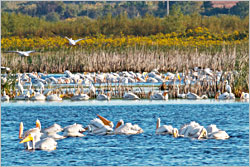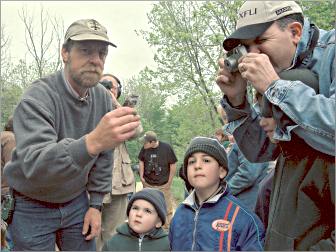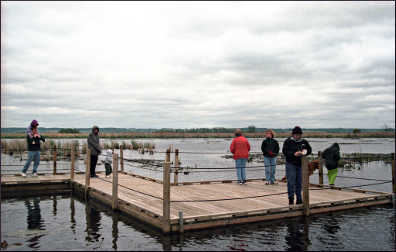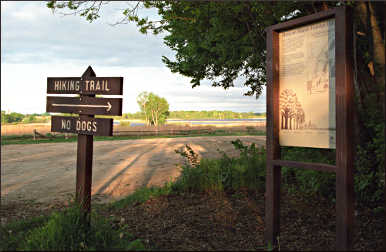Life on Horicon Marsh
At an avian rest stop, humans learn about life on the wing.

© Jack Bartholmai
On a spring morning in east-central Wisconsin, two geese suddenly shattered the stillness, honking urgently. Yellow warblers zoomed down from trees and out of sight. Redwing blackbirds clung to cattails, swaying in the stiffening wind.
It was only 6:30 a.m., but it was rush hour on the Horicon Marsh.
A human here feels oddly out of place, a lumbering interloper on a fast-moving avian freeway. Birds own this marsh, and they aren't shy about saying so, rending the air with trills and tweets as they go about their business.
This marsh, often called the Everglades of the North, is an important rest stop for migrating ducks, geese, warblers and other birds. It's also the home of great blue herons, egrets, redhead ducks and more than 200 other species.
Amid its amber waves of cattails, stretching 14 miles from north to south, hundreds of thousands of Canada geese and other birds stop to refuel along their journey.
A century ago, nearby farmers tried to claim the marsh for themselves, draining it and planting crops. But the wet, peaty depression, scoured out by a lobe of the last glacier, was no good for farming, and the U.S. Fish and Wildlife Service began to buy up the land.
Today, the 21,000 acres in the north is the Horicon National Wildlife Refuge, and the 11,000 in the south is the Horicon Marsh State Wildlife Area, administered by the Wisconsin DNR.
Both areas have hiking trails, observation decks and visitors centers. A 50-mile auto route girds the marsh, and the 34-mile Wild Goose State Trail skirts its western edge.
From April to November, naturalists and local birders lead tours and programs, delving into every aspect of the marsh's flora and fauna.
The biggest event of the year is the Horicon Marsh Bird Festival in mid-May, which gives expert birders as well as novices a close look at action in the marsh.

© Beth Gauper
Starting at dawn, programs fly thick and fast — bus tours, bird-banding demonstrations, boat tours, bird-call identification classes.
During one festival, I headed into the marsh just as the sun rose over its patchwork of islands and sloughs. Near the town of Horicon, the wood-chip Horicon Habitat Trail heads into a forest and along the edge of the marsh.
Birds are everywhere: large families of geese, bustling around a grassy hillside; red-winged blackbirds; warblers; and great blue herons, whose nesting colony on nearby Fourmile Island is the largest in Wisconsin.
Circling back, I came upon a bird-banding demonstration led by DNR naturalist Bill Volkert, who had gone out at 4:30 a.m. to stretch a fine black net along a hedge of honeysuckle bushes.
The net had done its work, and now birds hung in mesh onion bags on a clothesline, waiting to be banded.
But before he banded the birds, Volkert showed them to an intent cluster of onlookers.
"This guy has absolutely no fat," he said, blowing aside the feathers on the belly of a northern water thrush. "He's just burned up all his fat, and his gas tank is on empty. If he's going to get up north, he has to spend some time here."
A magnolia warbler, on the other hand, was downright chubby — its belly was yellow with fat — and would leave as soon as the wind shifted.
"He came with the south wind a few weeks ago," Volkert said. "These birds unerringly come back to the same spot. Three years ago, I found a yellow warbler I banded nine years ago, and she already was an adult then. So she was 10 years old, flying 2,500 miles each way, and always right to these bushes."
As he talked, bird calls rang out from the bushes.
"Hear that 'reap-reap-reap' "? he asked. "That's a great crested flycatcher. And that real sharp 's-s-s-s' — that's an American redstart. I've been hearing Tennessee warblers all morning, and — ah — there's a Blackburnian warbler."
From the crowd, a woman's voice piped, "Isn't that amazing? All I can hear is a cardinal call and a mourning dove coo."

© Beth Gauper
For those who can't tell a sparrow from a swallow, the program was a Cliff's Notes to birding.
As Volkert plucked birds from the net, we got close-up views of markings many can see only in books — the fuchsia throat of a hummingbird, the peach breast of a barn swallow and the greenish-yellow cap of a chestnut-sided warbler,.
We also got two "special surprises" — a Lincoln's sparrow and a bay-breasted warbler, both hard to find.
After the demonstration, I worked my way around the marsh counterclockwise, driving deep into the marsh on the Dike Road, stopping to look at exhibits at the Visitors Center and Marsh Haven Nature Center, and hiking on the lovely trails off the Horicon TernPike, a 3.2-mile one-lane auto route in the northwest corner of the marsh.
The half-mile Egret Trail, partly a floating boardwalk, apparently was the domain of purple martins, who were dive-bombing anyone who wanted to walk on it.
Killdeer stood on mounds of mud, next to the zigzagging boardwalk, which went through a gazebo and over a bridge before segueing into a forest path lined with trillium and May apple.
The peaceful marsh is a respite for birds, but also for bird-watchers, whose pastime is growing faster than any other in the United States.
One regular at the marsh is Mary Kay Duckstein, who lives in Chicago but has a second home in nearby Green Lake and often drives down to take pontoon-boat tours from Blue Heron Landing in Horicon.
"This is a very relaxing hobby," she said. "You get up, you go out and you watch. It stops you. It stops you from doing all the other crazy things you do."
Trip Tips: Horicon Marsh in southern Wisconsin
Getting there: Horicon, on the south end of the marsh, is about an hour northwest of Milwaukee. Waupun, at the northwest side of the marsh, is about 20 minutes southwest of Fond du Lac.
Bird Festival: It's held the second Friday-Monday of May. Sign up early for tours and field trips.
Other programs are free. Sponsored by the Horicon Marsh Bird Club. For details, call the DNR field station at 920-387-7877.

© Beth Gauper
Horicon Marsh State Wildlife Area: The DNR field office on Palmatory Street, just north of Horicon, has information on birding and maps for hiking and canoeing. 920-387-7860.
Horicon National Wildlife Refuge: The Visitor Center in Mayville is open Mondays and Thursdays-Saturdays in April and May. Hours vary by season. 920-387-2658.
Accommodations: In Horicon, the Victorian Honeybee Inn B&B is walking distance from the marsh. It has four rooms, two with double whirlpools. 920-485-4855.
Bicycling: The 34-mile crushed-limestone Wild Goose State Trail goes between Fond du Lac and Clyman and cuts through many different bird habitats.
Canoeing: Canoeing is allowed in the 11,000 acres of the Horicon Marsh State Wildlife Area, the southern third of the marsh.
Hiking: The two-mile Horicon Habitat Trail at the southern tip of the marsh is just north of the town of Horicon; from Wisconsin 33, or Lake Street, turn north on Palmatory Street.
The trails off the Horicon Ternpike, just east of Waupun, are open all year; autos are allowed on the road between April 15 and Sept. 15.
Information: Horicon tourism, 920-485-3200.